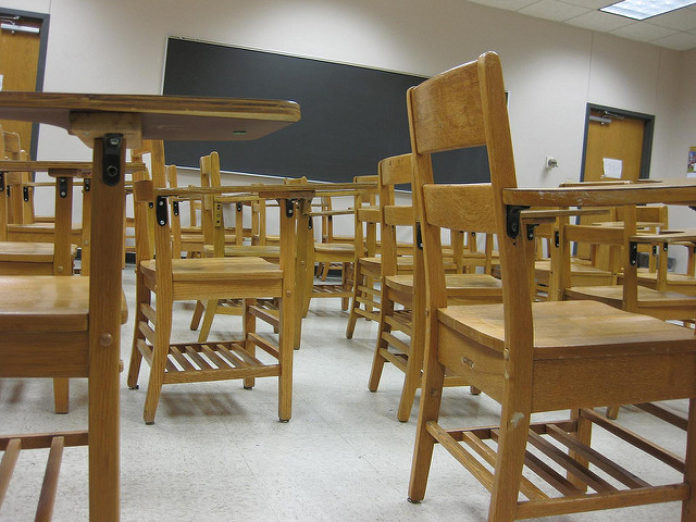
School administrators start evaluating classroom sizes for the next year before the current year is over, and continuously monitor them.
It’s a never-ending process.
Predictions
Warsaw Community Schools has a “line” it tries to follow, said Superintendent Dr. David Hoffert. For kindergarten through third grade, Hoffert said they try to keep classrooms under 25 students. For everything above third grade, WCS tries to keep classrooms below 30 students.
Those are maximum class sizes, he said, but the ratio across the district is about 1 to 17. “That includes (English learners) and special needs teachers, as well, so that brings down some of the numbers, but when you look at it again, we watch very closely those numbers and what they’re going to be,” Hoffert said.
Kindergarten roundup in the spring plays a key role in the Tippecanoe Valley School Corp. “Those numbers … (are) a big determination on the overall enrollment that you’ll have in the upcoming year,” said Superintendent Blaine Conley. “If you graduate a small class and you have a large kindergarten class that comes in, you’ll have a higher overall enrollment, or vice versa.”
He compared recent kindergarten enrollment to a roller coaster.
For kindergarten to third grade, he said Valley would like its class sizes in the high teens to low twenties. Beyond that, the class sizes grow.
“Ideally, it would be 24, 25 kids in those classes, but as you progress through K-12 education, classes get larger,” he said.
At the middle school, he said, changes in scheduling and a large eighth-grade class have led to science and social studies classrooms with 30 or 31 kids in them. “We’re always looking at ways we can structure things to help focus on just the instructional aspects of what we need to provide our students,” Conley explained.
The second step for WCS is the school registration process, which usually begins June 1.
“It’s why we highly encourage people to register early,” Hoffert said. “Some people wait until the last second, but with online registration, we’re able to get those numbers and continue to monitor them.”
Kindergarten enrollment also gives them an idea, he said.
Scheduling
WCS tries not to have any classroom under 15 students. It stopped offering half-day kindergarten about four years ago when only 11 students were signed up.
Special circumstances, especially at the high school, can mean some adjustments, Hoffert said.
Advanced Placement Advanced Engineering class could be combined with a couple of Independent Study students so the classroom doesn’t fall below the minimum class size.
Or in some high school art classes, there are only enough seats for so many students because of the lab space required. Hoffert said those classes could be limited to 20 students or less. Those are “very specific classes,” he said, “but they’re very important for the kids that are taking them.”
The school also might adjust by offering a course every other year.
In the spring, Valley looks at how the high school students are scheduling for the coming year. “You hope your teachers have multiple licenses that we can provide opportunities for students that way and meet their needs,” Conley said.
He said the state’s Career Pathways strategy is a huge influence on high school students’ course selections, and it begins in the eighth grade for them.
According to the Indiana Department of Education website, Career and Technical Education pathways prepare youth for a wide range of high-wage, high-skill, high-demand careers.
Shuffling
When the school year begins, some classroom shuffling takes place.
“We really look at those numbers in the elementaries, the K through 2,” Conley said. “We don’t want classrooms with 28, 30 kids in there. So we look at that point where we can bring those down to the low twenties and the high teens.”
Hoffert said, “There’s registration numbers and then there’s numbers of kids that actually show up. A lot of times over the summer people will move, even inside the school system.”
One year at a Warsaw elementary, 16 kindergarteners didn’t show up on the first day of school even though they had registered, Hoffert recalled.
“Everything was there. Most of them moved to other schools. … But it wasn’t even in-district transfers. They just (moved out of district),” he said.
Kindergarten enrollment was down this year at Madison Elementary, so a teacher moved to fifth grade, which was up. One teacher moved from Lincoln to Leesburg kindergarten because Leesburg’s numbers “skyrocketed” this year, Hoffert said.
“We try to watch very closely where apartment complexes are going up, where new additions are going in because when it starts getting to be more than a year up and down, we start looking at ‘do we need to adjust the lines?’ Because we know there are capacities at certain schools,” Hoffert said.
Conley said, “There have been situations where we started school and made a decision on adding a section. We didn’t have to do that this year, but that has happened in the past. We really want to try and keep those class sizes manageable.”
Adjustments
WCS administrators and the school board review enrollment numbers during the school year so adjustments can be made as needed. “We take this very seriously because, first and foremost, of student learning,” Hoffert said.
Conley said, “We really do monitor transfers, students that leave throughout the year, and students that we have come here. We really try to find out the reason why those situations occur, both ways, and we look at it on an individual basis and it’s been good to get to know our families and the reasons they do come here. They feel like we offer a great opportunity for their kids and a great education.”
He said many times when a family moves away it’s because of the parents’ jobs.
School corporations get paid by the state per student. The student count day takes place in September. “They actually have to be enrolled and attending,” Hoffert said.
At Warsaw Schools, enrollment has stayed neutral over the last four to five years, Hoffert said – right over 7,000. “So that means our class sizes are usually somewhere between the range of 515 to 550,” he said.
WCS is an open district, which means students can transfer in and out, but the school corporation hasn’t seen a large fluctuation. Last year, WCS gained 30 students throughout the year and had to adjust, partially by providing instructional assistants to classrooms.
At the elementary school level, Hoffert said there’s never been a classroom of 35 students. When a classroom is larger than the desired size during the first week of school, an adjustment is made.
At Valley, Conley said, “I want our teachers and our staff to focus on the kids that we have. As the superintendent, I’m charged with really working on marketing our schools and making choices that are appealing to families to come here. We’ve continued to really offer a lot of different programming for students.”
He said at Valley, they like to talk about Valley Family and Valley Pride. “And when you come here, you’re really a part of a family that you can really be a part of – any team, any organization, any club and be successful at that if you’re willing to put some effort in.”




